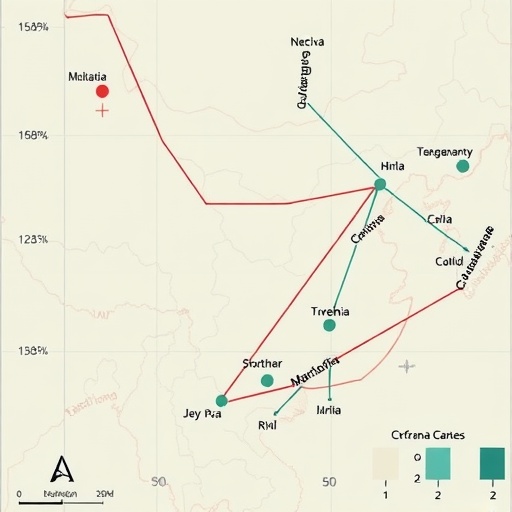In recent decades, the global epidemic of diabetes has emerged as a significant public health challenge, particularly in densely populated countries such as China. A collaborative study conducted by researchers Zhou, Liu, Zhao, and their colleagues provides a comprehensive analysis of the national and provincial prevalence of diabetes in China from 2005 to 2023. This work evaluates not only the statistical data from previous years but also projects future trends concerning the disease up until the year 2050. With diabetes continuing to rise to alarming levels, understanding its ramifications, prevalence, and anticipated impacts is crucial for effective public health strategies.
The study dissects the landscape of diabetes within China’s various provinces, presenting a granular look at how the disease’s distribution and severity differ across regions. It underscores the disparity in prevalence rates, reflecting the socio-economic variations and healthcare access discrepancies inherent in such a vast nation. By examining localized trends, the research fosters a better understanding of how regional factors, including urban versus rural settings, influence diabetes incidence. This regional analysis is essential, as tailored public health interventions can better address unique population needs.
Moreover, this research sheds light on the non-fatal burdens that diabetes imposes on the Chinese population. Unlike many health issues, diabetes doesn’t solely threaten life; it significantly deteriorates quality of life through various complications. Chronic conditions associated with diabetes, such as cardiovascular disease, neuropathy, and nephropathy, not only impact individuals’ health but also place a substantial burden on healthcare resources. The study effectively quantifies these burdens, illustrating how the ramifications of diabetes extend well beyond its direct health impacts, affecting economic productivity and quality of healthcare.
As the prevalence of diabetes in China continues to escalate, underlying factors such as dietary changes and sedentary lifestyles are fundamental contributors to this trend. The research highlights the rising trend of obesity in China, exacerbated by urbanization and the adoption of Western dietary patterns. It is increasingly clear that as lifestyle habits shift, populations risk stepping into an epidemic of lifestyle-induced diseases, including diabetes. This study aims to create an awareness of these lifestyle modifications and stresses the importance of preventative measures, particularly in younger demographics.
In projecting diabetes prevalence to 2050, the research utilizes sophisticated modeling techniques that incorporate demographic data, lifestyle trends, and health interventions currently in place. By predicting the future burden of diabetes, public health authorities can better anticipate the resources needed to manage this growing epidemic. The projections suggest a concerning trajectory that underscores the need for immediate and substantial policy changes to curb diabetes rates and mitigate its impacts across all societal levels.
The scope of this study is notable, with data collected from various national health surveys and provincial health records, ensuring a robust and representative dataset underpins the findings. The meticulous methodology employed adds credibility to the projections and analyses presented. Thorough data validation processes, including cross-referencing and multivariate adjustments, amplify the robustness of the outcomes, allowing for confident assertions regarding the future landscape of diabetes in China.
Additionally, the initiative emphasizes the role of public health education and awareness in combating diabetes. The need for targeted campaigns aimed at raising awareness about risk factors, symptom recognition, and lifestyle changes is paramount. Such efforts could empower individuals with the knowledge necessary to take proactive steps in managing their health. The researchers argue that fostering a more health-conscious society is one of the most effective strategies to mitigate the looming diabetes epidemic.
This research is timely and aligns with the global healthcare agenda, particularly in light of the ongoing pandemic that has exposed vulnerabilities in health systems worldwide. The findings underline how systems can be overwhelmed when chronic diseases such as diabetes are not effectively managed. Furthermore, the pandemic’s impact on individuals with pre-existing conditions like diabetes has starkly illustrated the urgent need for integrated health care systems that can support disease management comprehensively.
Ultimately, the work of Zhou and his team represents a significant contribution to the field of chronic disease epidemiology in China. By examining not only the prevalence of diabetes but also its longitudinal increase and future projections, the research provides invaluable insights for policymakers and healthcare planners. It presents evidence that will drive informed decision-making and allocate resources effectively within the nation’s health landscape.
The publication of this study in a reputable medical journal underlines its importance and relevance within the context of military medicine and broader public health discussions. The understanding of diabetes’ burden within military populations—who often face unique health challenges—further enriches the findings, as it calls for specialized interventions and consideration in the design of health policies.
As public health discussions around chronic diseases escalate, the interplay between governmental policy, healthcare access, and individual health choices becomes increasingly apparent. The urgency of addressing diabetes within China cannot be overstated, and this research serves as both a warning and a guide for future actions to prevent further escalation. The careful modeling and projections presented should guide the development of forward-thinking public health strategies.
In conclusion, the study conducted by Zhou, Liu, Zhao, and their colleagues is a wake-up call regarding the diabetes epidemic in China. It not only outlines the current state of diabetes but crucially emphasizes the need for preventative action. As diabetes continues to pose a threat to public health, understanding its trajectory and implementing appropriate policies will be vital in shaping a healthier future for China’s citizens.
Subject of Research: Diabetes prevalence and burden in China from 2005 to 2023, with future projections to 2050.
Article Title: The national and provincial prevalence and non-fatal burdens of diabetes in China from 2005 to 2023 with projections of prevalence to 2050.
Article References:
Zhou, YC., Liu, JM., Zhao, ZP. et al. The national and provincial prevalence and non-fatal burdens of diabetes in China from 2005 to 2023 with projections of prevalence to 2050. Military Med Res 12, 28 (2025). https://doi.org/10.1186/s40779-025-00615-1
Image Credits: AI Generated
DOI: [Unavailable]
Keywords: Diabetes, Prevalence, Burden, China, Public Health, Projections, 2050, Chronic Disease, Health Policy.




